Culture
- Culture is a set of values observed by people.
- The values differ from tribe to tribe.
- There are various parameters that one can use to investigate the culture of a certain tribe.
- The paper investigates the culture of the Luo people as given by Maria Atieno, a 74-year old Luo.
Culture in simple terms can be defined as the general set of values that people observe in their day-to-day activities. Its rather interesting to realize that regardless of the many tribes that exist in the world, each has its own and unique culture. To find out the nature of the culture, one has to consider various parameters ranging from.
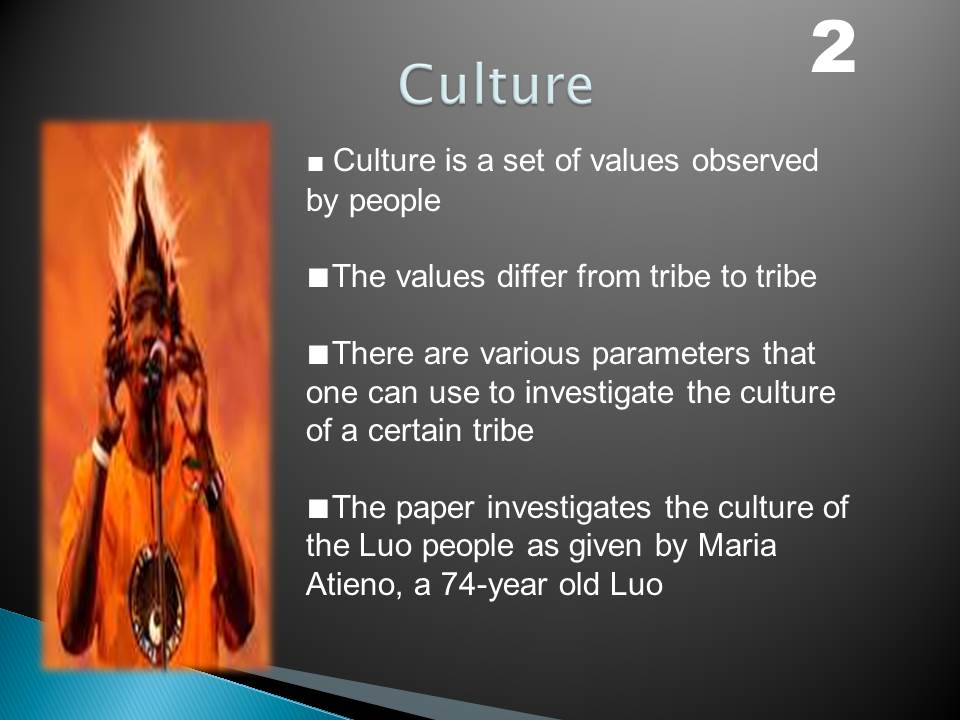
The Luo
- The Luo are the indigenous people of Kenya under the category of river-lake nilotes.
- They rank second in terms of population after the Kikuyu tribe.
- They are approximately 3, 300, 000 million in total as recorded in the 2009 population census.
The Luo people are the indigenous people of Kenya living around lake Victoria, which lies in the western part of the country. The tribe ranks second in terms of population specifically making upto 14% of the entire Kenyan population after the Kikuyu tribe who assume 22% of the population. The tribe came to Kenya from the north following the river Nile whose source is lake Victoria where they currently stay occupying the entire Nyanza province of Kenya.
- The Luo migrated to Kenya from the North of Africa through southern Sudan following River Nile in search of water for fishing.
- They settled around lake Victoria, which forms the source of river Nile.
Based on their migration, Geissler (1998) points out “…other Luo-speaking River-Lake Nilotic groups in Uganda and southern Sudan, whence the Luo migrated. The tribe migrated primarily to look for water for fishing as this forms their main business in Nyanza province” (p. 30). They have a population of approximately 3, 300, 000. Alongside is a photo showing a group of them in front of a grass thatched house common in the Luo land.
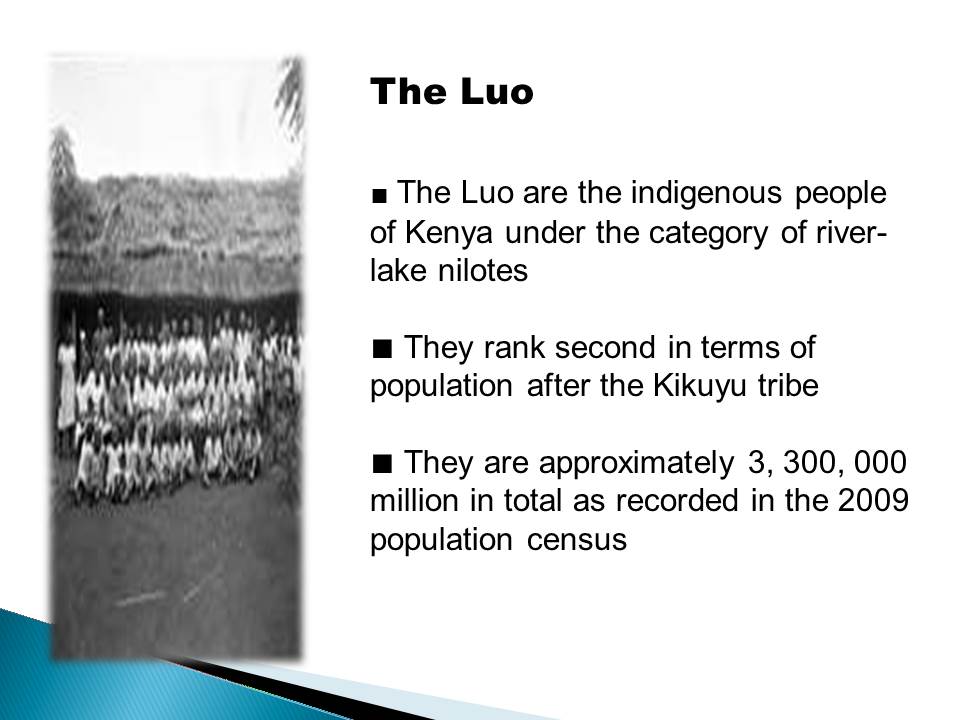

Communication
- The dholuo language is the dominant vernacular language.
- It is the most popular language in Kenya with other language speakers wishing to know it.
- A Luo person speaking can be mistaken for another speaking in English.
- Omera is the common term for young men while Nyako is for young women.
- While other tribes prefer conversing in Swahili– Kenya’s national language, to their vernacular languages, the Luo’s case is the reverse.
- Winking is considered a sexual invitation.
- Nodding one’s head up and down is equivalent to acquiescing.
- However, shaking it sideways is a negative sign that implies denying.
99% of the people living in Nyanza province speak dholuo language. The language seems so popular that other tribes attempt to copy some of the common dholuo words like Omera, erukamano, kwuon, berr amongst others all of which are commonly associated with the mid-aged group. The learned people from the Luo land prefer mixing both dholuo and English to the level that one cannot tell English from dholuo from a conversation.
Closing of one’s eyes sporadically is interpreted as a way of expressing one’s sexual desires. Nodding of head on the other hand suggests acquiescing while shaking it sideways implies denial of something like a request to do something.
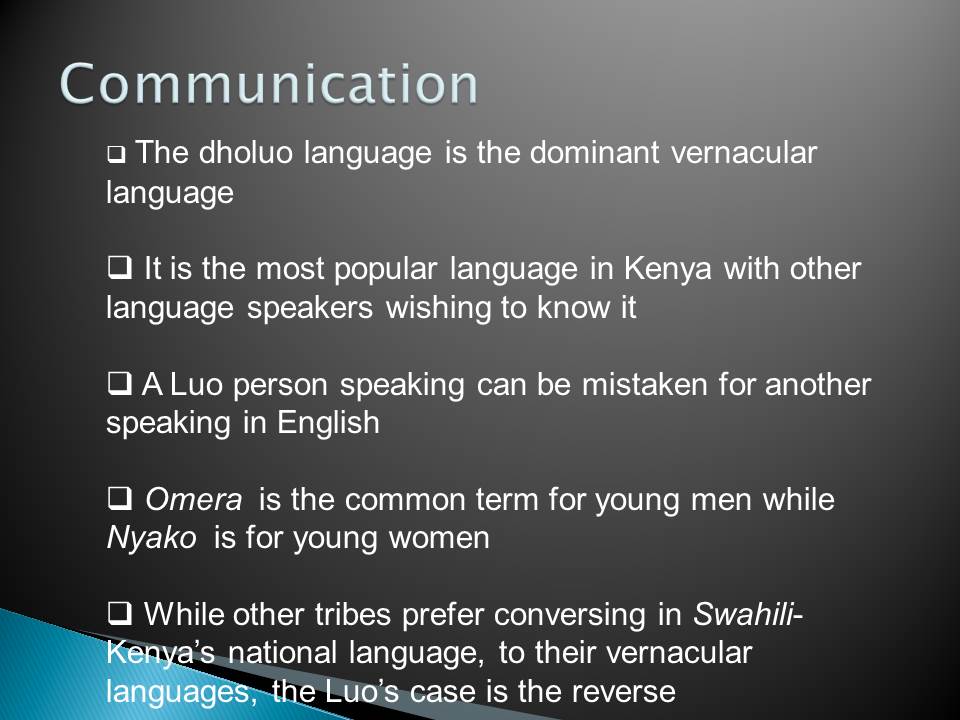
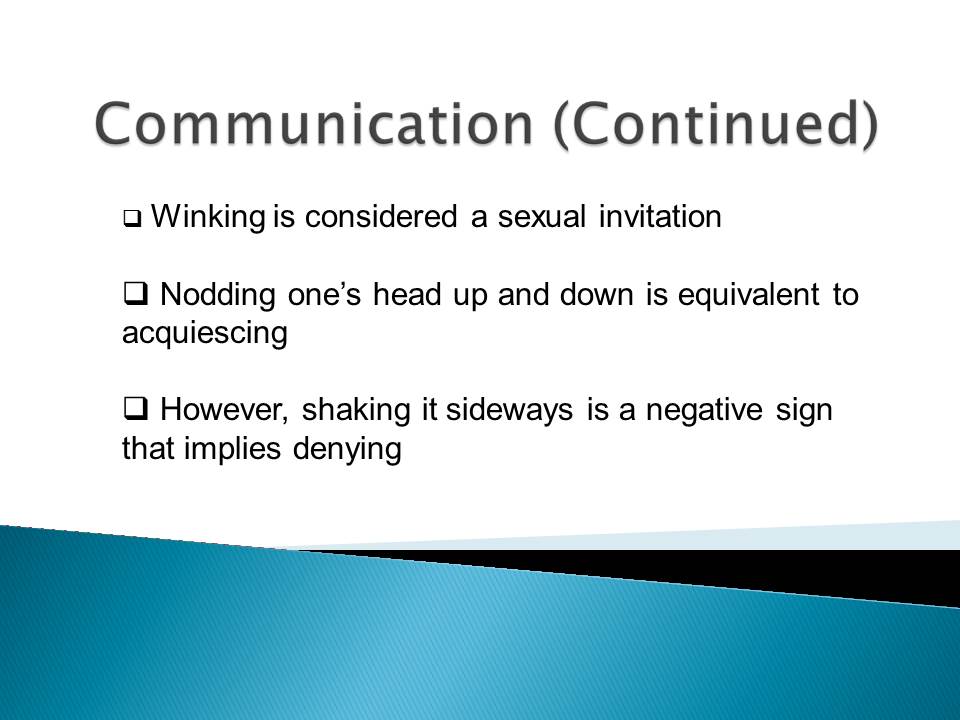
Greetings and Names
Greetings
- All Luos shake hands firmly as a sign of respect.
- The right hand has to firmly hold the left.
- The older person is expected to utter the words Ithinade (how are you) to the younger who then responds Athimaber (I am fine).
- Eye contact is highly valued in any conversation, leave alone greetings.
- An old Luo person in a conversation with a stranger prohibits his/her great-grand children from nearing the conversation zone.
The Luo people greet one another by shaking each other’s hand: left to the right. Such a greeting is viewed as sign of respect. Failure to greet a person passed for lack of respect that can result to a stern punishment of heavy work from the Luo elders. While greeting or conversing with another person, the two or more parties have to maintain a constant eye-contact. An old Luo person with a great-grandchildren highly prohibits them from coming closer to an area where the person his having a dialogue with a stranger. This prevents any chances of the stranger jumping over the children or the children passing over the feet of the stranger. Such an action would inhibit the growth or prosperity of those children, while transferring whatever opportunities they might have had to the person who jumps over them.
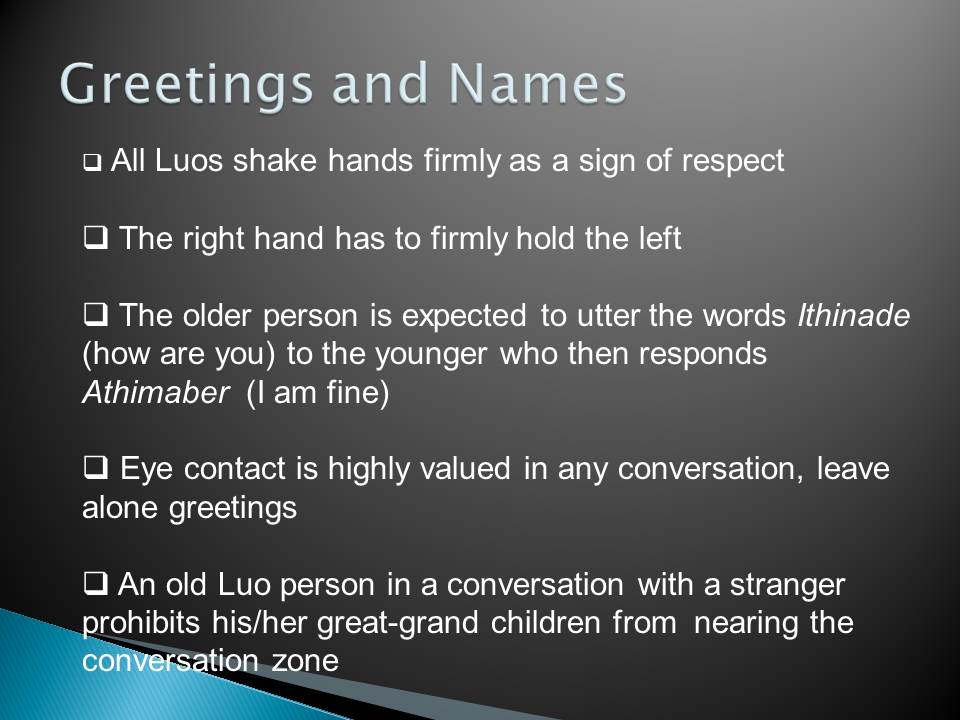
Names
- Most Luo names begin with Vowels A and O.
- Any name beginning with O is for a male person.
- Any name beginning with A is for a female Luo person.
- Male names range from Ouma, Otieno, Okinyi,Omondi, Obama, Oyoo, Oloo, Ochoo, Oketch etc.
- Female names follow the same criterion but beginning with A. i.e Auma, Atieno, Akinyi etc.
It so funny to realize that 99% of Luo names begin with either O or A. Any name beginning with O is automatically for a man while the reverse is also true. In case of the birth of a twin, the name given to them is similar with the only difference being the O and the A like the case of Adhiambo (the female) and Odhiambo (the male). The practice is only associated with the Luo. Barrack Obama, the president of America was born of a Luo father and hence the name Obama-beginning with O.

Family roles and organization
- Most Luo families are patrineal.
- The father is the breadwinner and owners of the household.
- He has to provide housing, food, clothes, education for his children.
- The wife is the manager of the family.
Most Luo families are patrilineal with the father being the head of the household. The wife and her children live on the husband’s property or homestead, dala in Luo language, with the male children marrying and building huts within the same homestead while girls left to live in their husbands’ homesteads (Ayikukwei, Ngare, Sidle, Ayuku, Baliddawa, & Greene, 2008, p. 590). The father has cater for the educations needs of his children. The wife on the other hand manages the family by making sure that the husband is physically fit in terms of dressing. She has to report any issues pertaining to the health and education of the children to the husband. Above is a picture of a typical Luo homestead with the father standing in front of his house while is mid-aged children are busy in the shamba while the young kids are in school keenly listening to their teacher.
- Polygamy happens in large scale among the Luo people.
- Luo men can marry as many as 10 women.
- Married women are expected to give birth to as many children as possible.
- The elderly men and women teach their grandchildren about their culture through folk tales.
The Luo community leads when it come to the practice of polygamy. While most other tribes campaign for one husband-one wife, the Luo seem deaf on the campaign as it proves hard to find a Luo man marrying one wife. According to them, the more the wives, the more the children and consequently the more the blessings. Therefore, married women have to give birth to as many children as possible. The older folk introduces their grand children to their cultural practices practiced even by their earlier forefathers through folk tales. The first photo above respectively show two women married of the same husband. They are from the market. The second shows a pregnant woman while the third shows polygamous Luo men with their many wives.
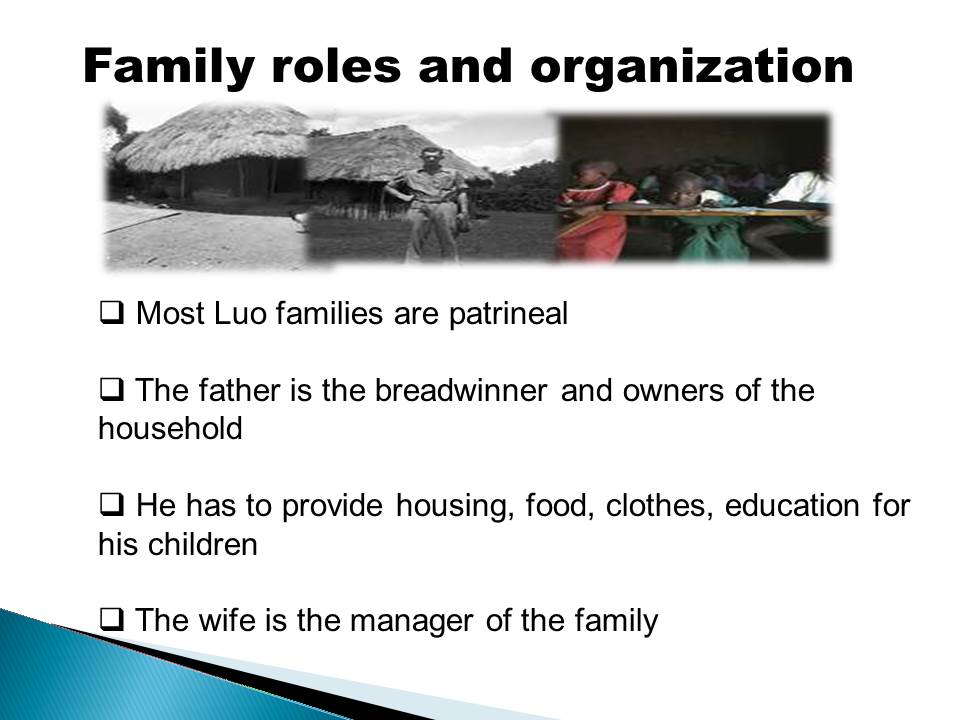
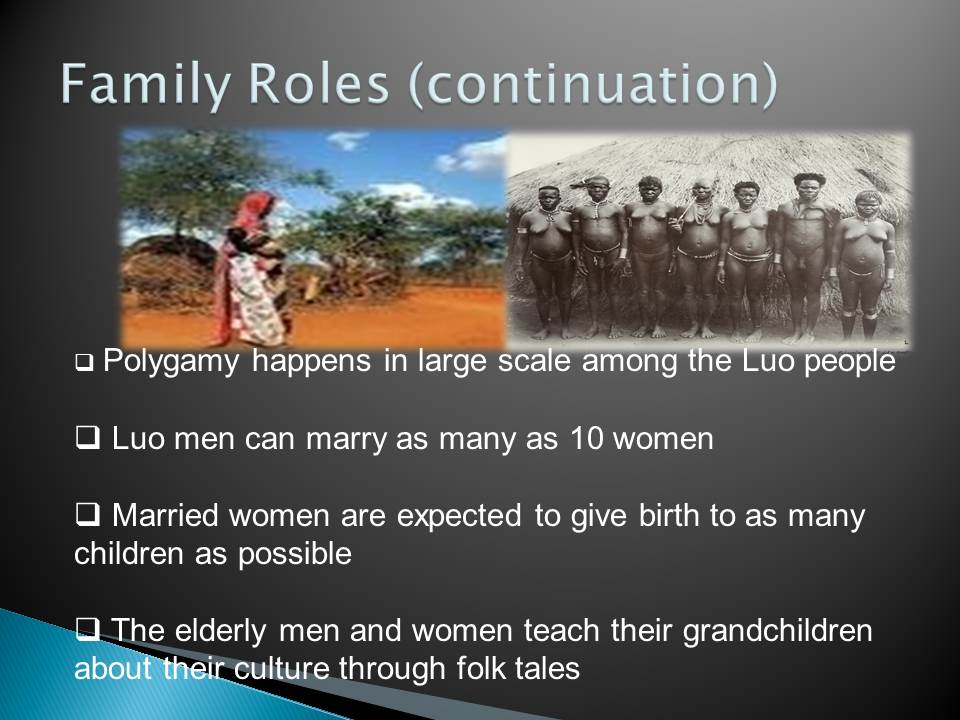
Nutrition
- Meat is necessary for ever meat coming in form of omena’, fish (rech), beef, pork, mutton and even some birds-doves, (aluru).
- Vegetables are very common in the Luo land.
- Omena is specifically served with ugali.
- Fruits are not such a priority in meals; they are seasonal in Kenya, and so eaten only when in season.
Meat is necessary have for every meal, back home, they cook ‘omena’, fish (rech), beef, pork, mutton and even some birds-doves, (aluru) for meat. Meat in the US is only readily available as steak, burgers, fried chicken, fish, or any other form. Back home, maize meal or ground cornmeal is the staple food. Almost every day she cooks ugali for her household, and in the event that they cook anything else, such as rice, a small piece of ugali will still have to be cooked for the meal to be complete. Fruits are not such a priority in meals; they are seasonal in Kenya, and so eaten only when in season (Gannon, 1994, p. 16). Vegetables on the hand are very popular and they exist in plenty, both as planted produce and in the wild. In Nyanza province alone, which is the region occupied by Luos in Kenya, there are over 67 different types of vegetables. These are served with the maize meal (Orech, Hansen, & Friis, 2007, p. 525).
- Omena can also be served with chapati.
- It can also be ground into a powder that is used for cooking porridge mostly for young Luo kids.
- Githeri, though not the preferred food is mostly taken by the women married by the Luo people but from other tribes.
Omena, the most common fish among the Luo market can as well be served with chapati. However, for the new born children, it is ground into a flour that is cooked as porridge. This makes the daily meal for children aged 1-3 years, as it is viewed as healthy. Githeri is majorly for those women married by the Luo men from other tribes.
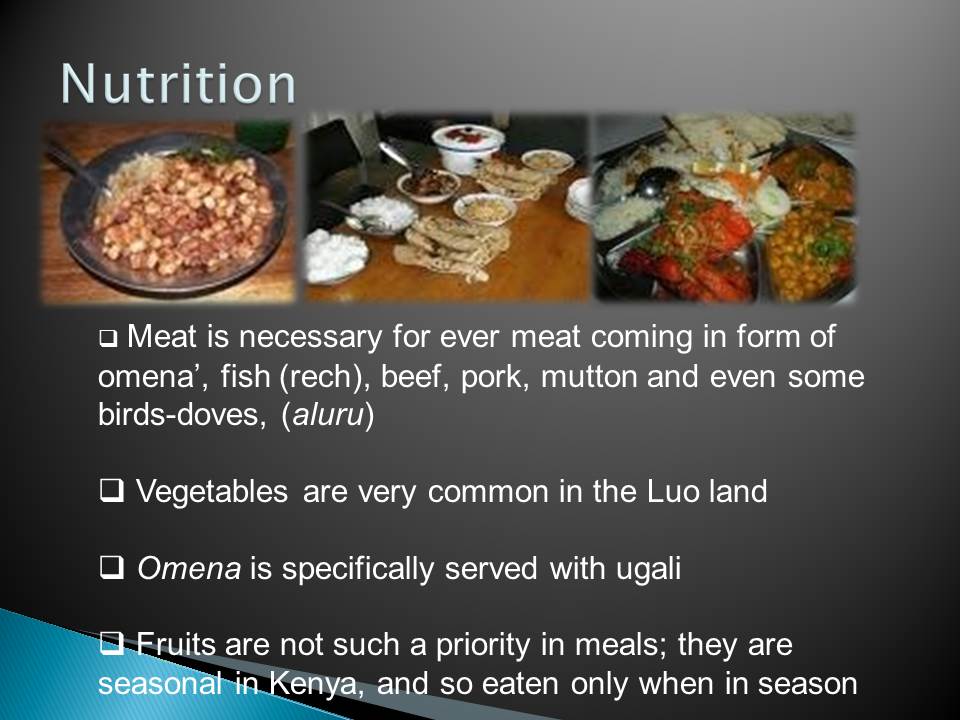

Work Force Issues
- Luo men are the breadwinners.
- Women mostly engage in passive jobs like taking care of the children.
- They also do most of the farming as their husbands are busy with their other works.
Luo men are the breadwinners, while women take passive roles like staying at home to look after children, while also doing most of the farming. Boys go out to take care of livestock or to fish while girls remain with their mothers who teach them how to behave to win the adoration of men. Girls also collect firewood and collect water for domestic use (Ayikukwei et al, 2008, p. 594). The photos above show a Luo family with the head (the father) sited in front. The wife is sited besides him while the children are behind them.
- Boys take care of the live stock and also do the fishing job.
- Women and girls perform most of the domestic chores.
- Girls begin new families while young thus avoiding most of the school work.
- Beauty also plays a significant role for some few Lou girls.
Women and girls are more into domestic chores (house helps), liberal arts, history, education, religion, language, and nursing. This comes in as a trend that begins at campus, all the way into their careers. Mostly, girls get married while in high school, and so they do not join the universities. Those who do not get married proceed to take simple courses such as home science or nutrition. Beauty also plays a significant role; the few girls who venture into technical areas such as engineering, mathematics or architecture are usually the ‘uglier’ or less physically attractive ones whom no man is interested. Above are photos of boys seriously working in the shamba and some girls in an entertainment session.
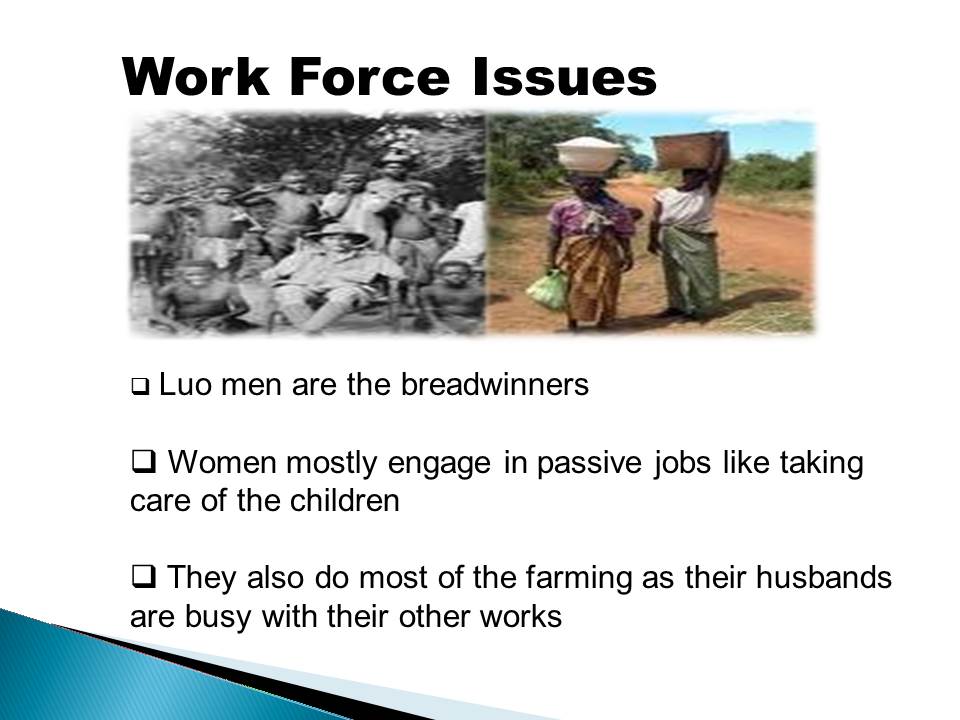
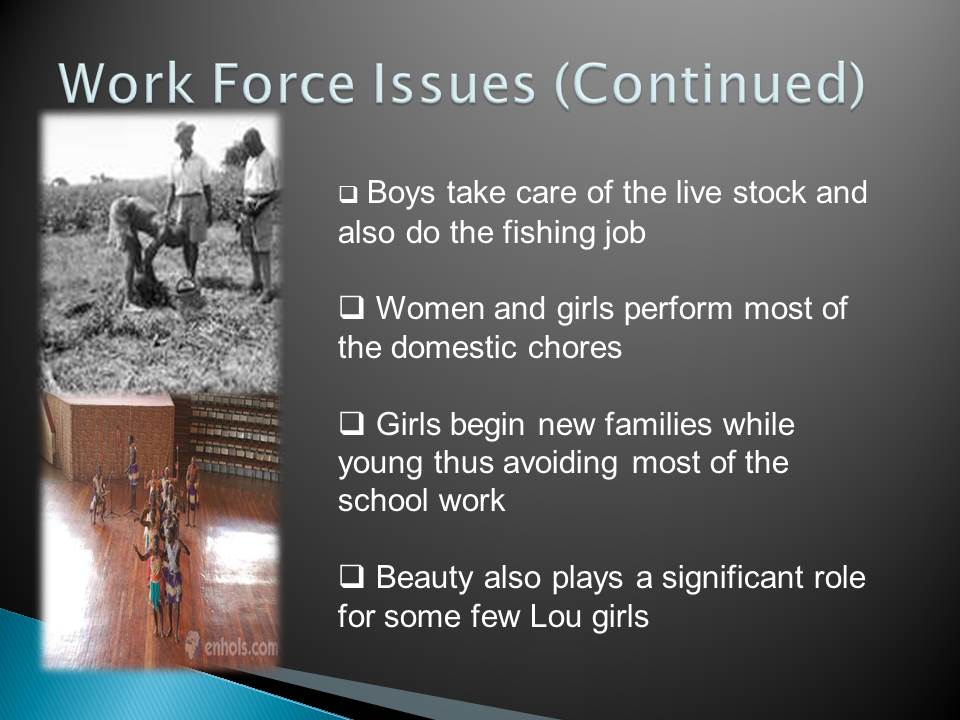
Biocultural Ecology
- Most of the Luo people are very dark in complexion.
- Most Luos are lean and tall.
- Colds and flu are therefore a common occurrence among the Luo people.
- The Luo believe that when one visits a place that is far from his/her home hence different in terms of climate and lifestyle, the worms (njokni) in his/her body are usually opposed to such change.
Majority of the Luos are very dark in complexion. Colds and flu are therefore a common occurrence among the Luo people. The Luo believe that when one visits a place that is far from his/her home hence different in terms of climate and lifestyle, the worms (njokni) in his/her body are usually opposed to such change. According to this culture, when people eat stale food (chiemo motop), they scream in protest (yuak chulululu) (Wenzel, Geissler, Nokes, Maende, Okatcha, Gringorenko, & Sternberg , 2007, p. 43).
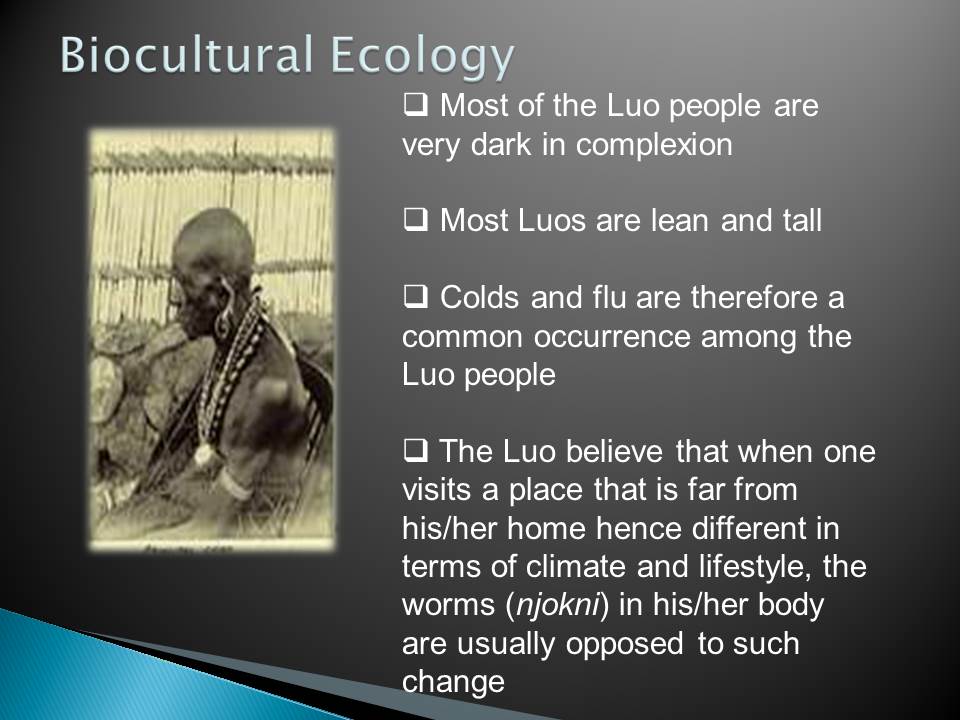
Pregnancy and child bearing practices
- Sex is only for married people as per the Luo culture.
- Women do most of the child bearing.
- Children are viewed as God’s gift, and the more one has, the more the respected he/she gets from the society.
Sex is only allowed between married people who then ought not to use any birth control method. Sexual relations before marriage are prohibited, homosexuality is unheard of (it never happens at all). Children are viewed as God’s gift, and the more one has, the more the respected he/she gets from the society. Children are also seen as a sign of wealth as only wealthy men can provide for such large families. They can also be a source of wealth in terms of marrying off girls with ‘fat’ dowries. However, the women being the ones who withstand the worst of childbearing are very innovative in terms of birth control.
- Abortion is a taboo, and deformed children remain believed to be a bad omen or a curse.
- Twins are not recognized as being ‘sufficient’ children.
- Pregnancy is a delicate stage for women.
- Children are raised in strict obedience to their parents.
Abortion is a taboo, and deformed children remain believed to be a bad omen or a curse. As a result, they remain locked away from the society for life with instances of killing them at birth standing out. Twins are also not recognized as being ‘sufficient’ children, often if a woman bears twins and then is widowed, pressure will be mounted on her to be inherited to bear more children (Wenzel et al, 2007, p. 225). Pregnancy is a delicate stage for women and the men acknowledge this. The woman’s mother therefore receives invitation to take care of her up until childbirth or the expectant wife goes to her mother-in-law up until she is ready to give birth. Children remain raised in strict obedience to their parents. They do not question directives: they comply. Corporal punishment is totally acceptable and advisable especially in the case of errant children.
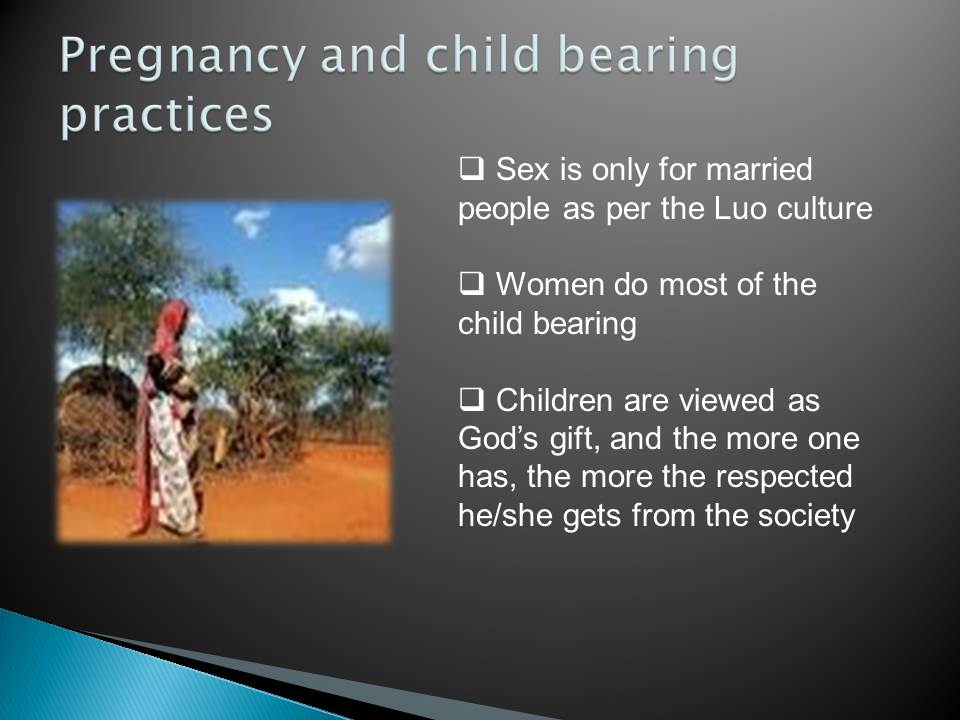

Death Rituals
- Death is a celebration accompanying funerals.
- When the head of a household passes away, the widow and her children shave their heads, and the central pole extending from the top of the hut is broken at the tip.
- Relatives must engage in sexual intercourse with their partners before and after the burial.
- If a married man dies, one of the husband’s elder brothers must inherit the widow.
The Luo literally celebrate death, like life. There is a myriad of festivities associated with funerals (Gannon, 1994, p. 17). Sex is a big part of these because Luos perceive it as a source of blessings and a way of preventing curses and other evil harm from coming one’s way (Ayikukwei, et al, 2008, p. 594). when the head of a household passes away, the widow and her children shave their heads, and the central pole extending from the top of the hut is broken at the tip. All the relatives are expected to engage in sexual intercourse with their partners before and after the burial as a way of bidding farewell to the deceased, as well as appeasing their ancestors to accept the deceased into their realm.
- Death stands out as a ‘rest’ from this troubled world.
- The inheritance has to be preceded by some sexual cleansing of the widow.
- Commercial cleansers, on the other hand, are sought when the cause of the husband’s death was a mysterious disease, or an evil force (chira).
- Failure to perform this ritual leads to discrimination and ostracism by the entire village.
The inheritance can only occur after such a widow has undergone a sexual cleansing ritual, which is believed to break the bond of her dead husband’s spirit over her body. This ritual is performed either by a professional cleanser (jokowiny) or by a family cleanser (jater). The elders usually prefer a family cleanser because they believe that he understands the cultures informing this sacred process. Commercial cleansers, on the other hand, are sought when the cause of the husband’s death was a mysterious disease, or an evil force (chira). Failure to perform this ritual leads to discrimination and ostracism by the entire village (Ayikukwei, et al, 2008, p. 595). After burial, a huge party is thrown for the next three consecutive nights. Death stands out as a ‘rest’ from this troubled world. Luos believe that the spirit of the dead lingers to watch over the remnant family. This prevents relatives from mistreating the orphans and the widow.
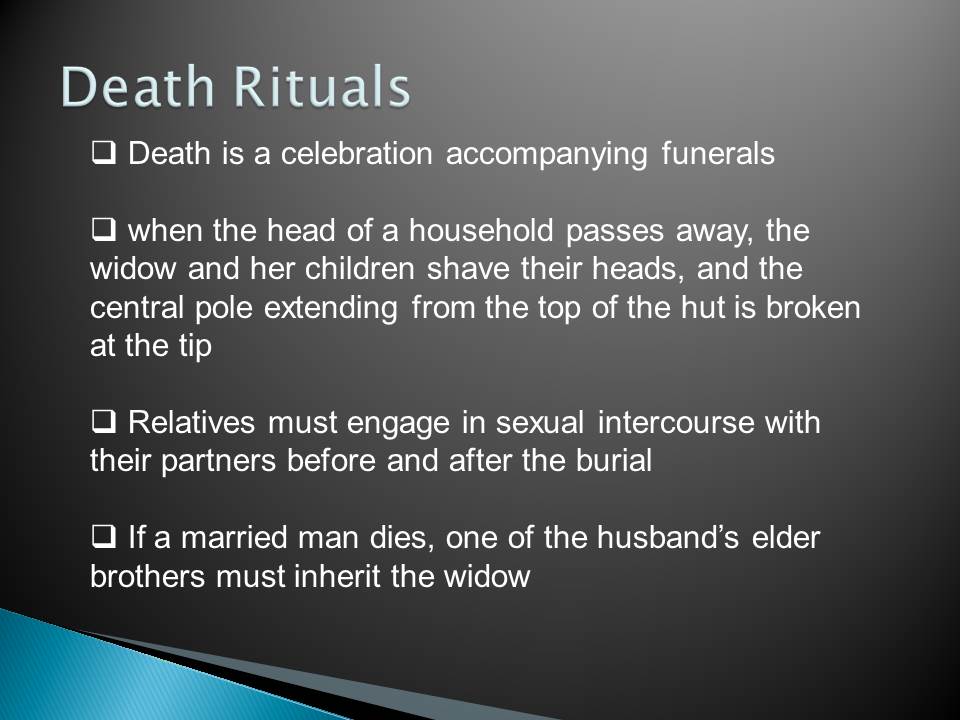
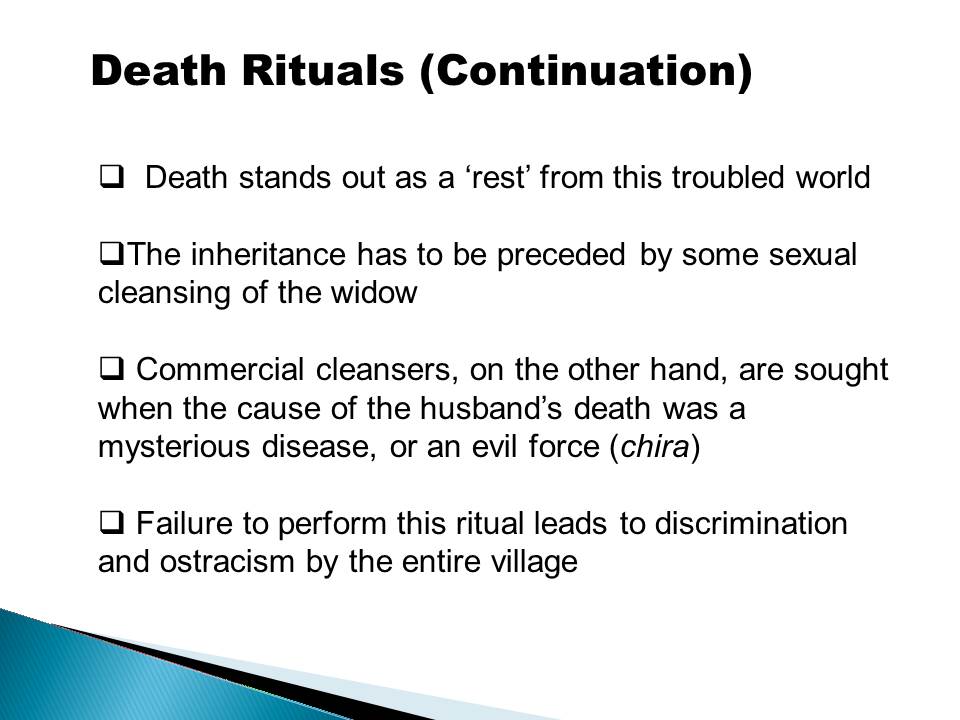
Spirituality
- Nyasaye is Luo name for God: Powerful and omnipresent.
- He is viewed as the healer of the sick.
- Majority of the Luo people are spiritual.
- Very few ascribe to the traditional ways of worship.
- They attend churches like the Pentecostal church, SDA, etc.
Nyasaye is the Luo name for God. Luos believe that human beings must acknowledge the existence of a ‘higher being’ in order to regulate their behaviors here on earth. When she gets ill, she believes that prayer can heal her but agrees that medical help is critical for the rejuvenation of one’s health. However, they insist that, it must be God’s will for the medicine to work for one to heal. This also applies for the traditional medication. The Deity is more powerful than any concoction than man may create for relieving illness. Above are photos of a Luo pastor of a Pentecostal church and Luo people keen attending to a sermon.
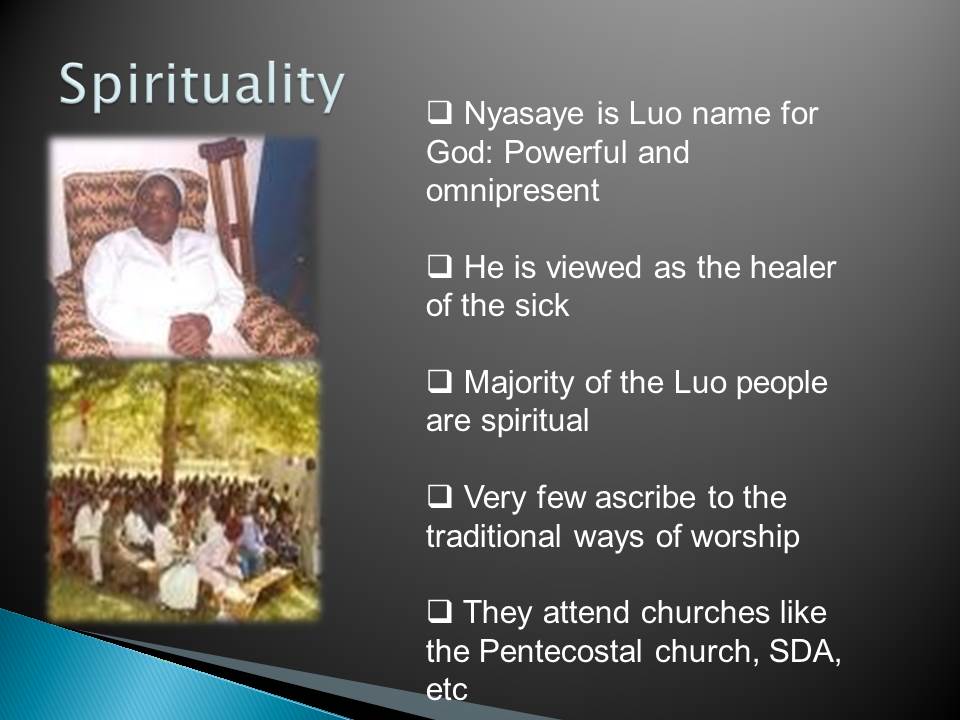
Health Care Practices
- All Luo people acknowledge the issue of health.
- Poor health translates to poor quality of life.
- There are evil people and forces that out there seeking to harm others.
- Majority of Luo people wear charms as a way of protecting themselves from those who can make them sick.
The Luo acknowledge that for one to be effective at whatever he/she does, be it studying or working, he/she has to be healthy. Poor health translates to poor quality of life. Culturally, there are measures that can be put in place to prevent people from falling ill. They believe that there are evil people and forces that out there seeking to harm others, which is why their families wear charms. However, others who do not share the same belief contact nurses as the above photos show several Luo nurses attending to sick people.
- The males wear a chain that has a shell, laced with garlic and pig oil.
- Females always wear a band on their waists, laced with the same concoction.
- Certain herbs are used to treat illnesses e.g. aloe Vera, neem, and green tea.
- Carrots improve eyesight and beetroot to increase blood levels.
- They believe that fish makes one more intelligent.
The males wear a chain that has a shell, laced with garlic and pig oil, while females always wear a band on their waists, laced with the same concoction. This concoction is also placed at the entrance of their house to ‘keep out evil’ which she believes is the source of all bad including poor health (Gannon, 1994, p. 20). The Luo believe that carrots improve eyesight and beetroot to increase blood levels. They also insists on the dual nature and purpose of worms in our bodies, and disapproves of the white man’s (wazungu) attempt to extricate all worms from the body (Geissler, 1998, p. 73). If they succeed in doing this, then one will die, because a person cannot live without worms (njokni) which move round the body causing various health conditions.
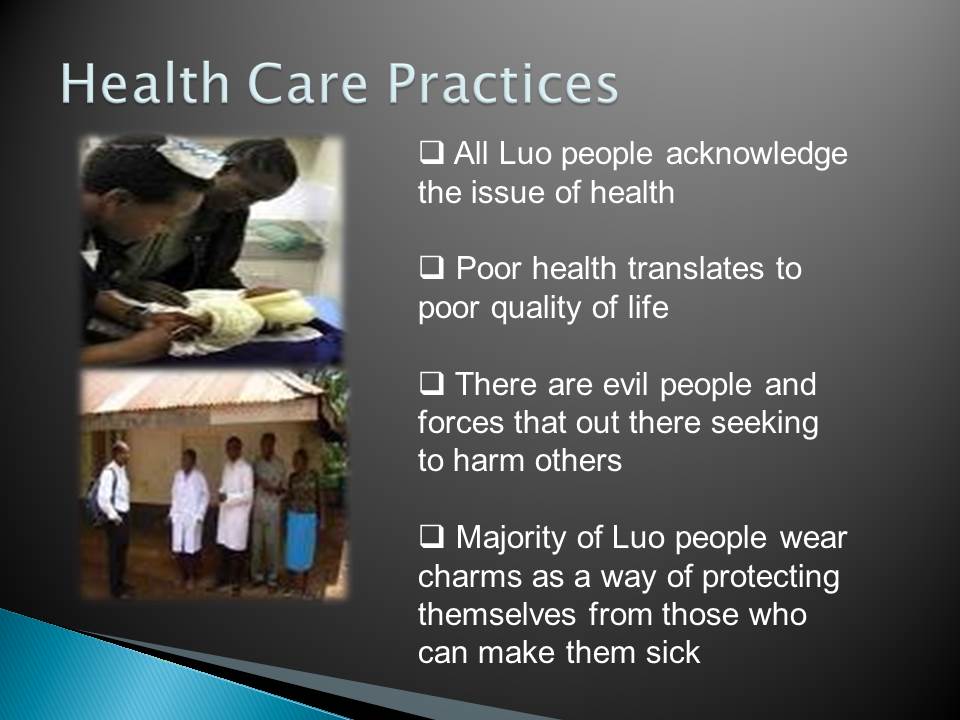

Implications for Nursing
- The role played by worms as the culture claims is a patient-nurse conflict.
- Sexual cleansing is believed to cause problems in terms of HIV prevalence.
- Trans-cultural nursing is crucial for practicing health care practitioners.
- Competent nurses need to familiarize themselves with these varying cultures.
Luos’ belief that worms are necessary for life is a good example of potential patient-nurse conflict in terms of medication procedures. The role attached to sexual cleansing may also cause problems in terms of HIV prevalence illustrating the importance of having informed nurses. Trans-cultural nursing is crucial for practicing health care practitioners in the US. This is because the population is fast becoming multicultural due to immigrations from different countries (Omeri, & Andrews, 2008, p. 90).
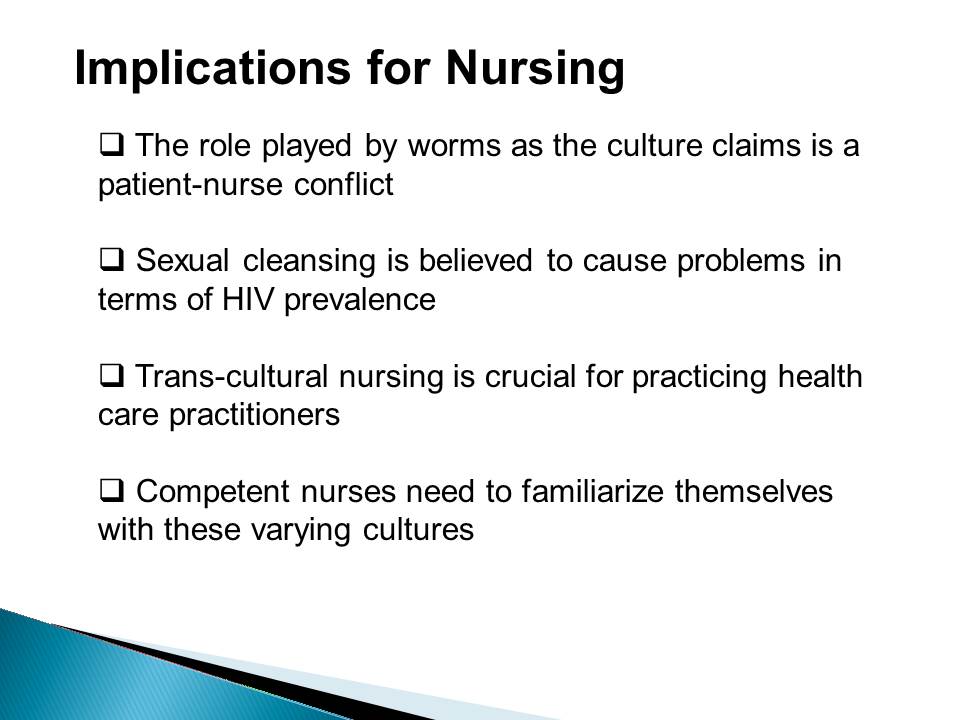
Reference List
Ayikukwei, R., Ngare, D., Sidle, J., Ayuku, D., Baliddawa, J., & Greene, J. (2007). Knowledge of herbal and pharmaceutical medicines among Luo children in western Kenya. Anthropology & Medicine, 8 (2/3), pp. 211-235.
Gannon, M. (1994). Metaphorical Journeys Through 17 Countries. In Understanding Global Cultures. London: Sage Publications.
Geissler, P. (1998). Worms are our life part 1: Understandings of worms and the body among the Luos of Western Kenya. Anthropology & Medicine , 5(1), pp. 63-79.
Omeri, A., & Andrews, M. (2008). Chapter on Meeting the Health Care Needs of the United States of America’s Diverse Society. In S. S. Daly J., Contexts of Nursing. Sydney, Australia: Maclennan & Petty, Ltd.
Orech, J., Hansen, A., & Friis, H. (2007). Ethnoecology of traditional leafy vegetables of the Luo people of Bondo district, western Kenya. International Journal of Food Sciences and Nutrition , 58 (7), pp. 522-530.
Wenzel, R., Geissler, P., Nokes, K., Maende, O., Okatcha, O., Gringorenko, E., & Sternberg, R. (2007). HIV/AIDS and cultural practices in western Kenya: the impact of sexual cleansing rituals on sexual behaviors. Culture, Health & Sexuality, 10(6), pp. 587–599.